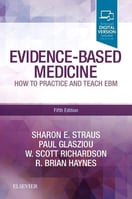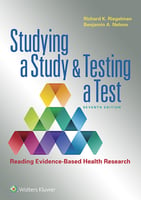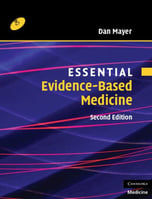Medical, Physician Assistant,
and Pharmacy Schools
Modules and curricula designed
to meet the needs of students
Flexible Approaches to Teaching
Explore our comprehensive guide to curricula examples for a variety of modern teaching strategies, including hybrid learning, blended approaches, team-based learning (TBL), problem-based learning (PBL), and exclusively online courses.





Text-book Coordination
Our content is cross-aligned with the most widely utilized textbooks on evidence-based medicine, ensuring a seamless integration of foundational knowledge and cutting-edge research.
Aligned with Accreditation Standards
Medicine
Supports LCME standards for EBM and preparation for Step 1

Physician Assistant
Meets ARC-PA standards for Physician Assistant students

Pharmacy
Supports ACPE accreditation standards for evidence-based practice

Modules
Goals and Objectives
EIDM1: Introduction to Evidence-Based Medicine
This module introduces the basic concepts and practices of evidence-based medicine and relates it to concepts to everyday life. It explores the role of probability in medicine, the information hierarchy, and the difference between patient-oriented and disease-oriented evidence.
- Explain what evidence-based medicine is and why it is valuable
- Describe the hierarchy of evidence sources
- Identify study outcomes as “patient oriented “or “disease oriented”
EIDM2: How to Make Decisions Better
This course delves into the process of making decisions in medicine, including common, predictable pitfalls. It gives learners several tools for policing their own decision-making processes.
- Explain the two different modes of thinking that are part of "dual process theory" and how they relate to making decisions in clinical medicine
- Use three questions to identify relevant new research findings
- Compare the traditional biomedical model of medicine with the probabilistic approach use in evidence-based medicine
- Describe the “Information Mastery Traffic Light” and use it to categorize current evidence in your clinical practice
DIAG1: Understanding How Screening and Diagnostic Tests Work
The only tests in medicine that are 100% accurate are the "birth test" and the "death test." All other screening and diagnostic tests have some degree of likelihood of giving false positive and false negative results. This module explains how to understand when tests results may not be what they seem.
- Explain how pretest probability can affect test accuracy (Bayes theorem)
- Use the test characteristics of sensitivity, specificity, and predictive values to correctly interpret test results
- Explain why simply using a test because it is highly sensitive or specific may not always be beneficial
DIAG2: Deciding If and When to Screen or Test
Just because a screening or diagnostic test is available doesn't mean it should be ordered for a patient. This module walks through the risks of indiscriminate use of tests, including the detrimental effect of false positive tests and the consequences of early diagnosis of disease and the concept of overdiagnosis.
- Describe the reasons why inappropriate screening or diagnostic testing can be harmful
- Explain the concept of a "critical point" in disease detection and how identification that is too early or too late can be harmful
- List the harms associated with early diagnosis, false positive test results, and overdiagnosis
PROG: Basic Concepts in Epidemiology and Evaluating Research About Prognosis
Useful information about the prognosis of a disease is necessary for making rational decisions about whether or not treatment is necessary and for counseling patients about the expected course of their disease. This module examines potential sources of information on prognosis and presents a method for quickly evaluating the relevance and validity of studies estimating prognosis.
- Contrast incidence and prevalence of disease
- Describe prognosis of disease and how it can be determined
- Determine if a study examining a prognosis is valid
THER1: Evaluating, Understanding, and Applying Results of Research Studies
This module explains how to evaluate research of a therapy for its relevance to you and its validity, interpret the results, and make treatment decisions.
- Explain the “usefulness equation”
- List the three questions needed to determine the relevance of a research article
- Describe threats to the validity of study evaluating a new treatment or therapy
THER2: Understanding and Applying the Results of Studies to Individual Patients
This module presents, without formulas (well, there's one, but it's simple), how to interpret the results of medical research to understand how it can be applied to individual patients.
- Explain how statistics are a representation of the truth but not the truth itself
- Interpret the p-value and confidence intervals of a study result
- Calculate the number needed to treat and explain its interpretation
- Explain the risk of the relative risk
PHARM: Identifying Misinformation and Evaluating Information from Pharmaceutical Companies
How should we make decisions regarding adopting a new treatment and discontinuing another? Since many treatments involve the use of pharmaceutical products or medical devices, we'll start by looking at methods used by these industries to influence our decision-making. We'll start off by looking at the profound effect advertising has on us and how our emotions can be manipulated to override our rational minds.
- Explain who advertising works and how it influences clinicians
- Describe fallacies of logic used to change clinician prescribing habits
- Describe other tools of advertising used to influence clinicians
REV: Evaluating Review Articles and Meta-Analyses
Reviews can be a great way to learn about a topic or to answer clinical questions. This module outlines how to identify distinguish systematic from summary reviews, the science behind review article writing, how the systematic review process works, and how to interpret results presented in a forest plot.
- Identify and explain the difference between a narrative (summary) review and a systematic (synthesis) review
- Evaluate a review article for both relevance and validity
- Interpret a forest plot and apply the results to patient care
GUID: Evaluating Clinical Practice Guidelines
Clinical practice are ubiquitous in medicine. However, they are not all created equal. This module explains the guideline development process and how to identify guidelines that are trustworthy.
- List sources of clinical practice guidelines
- Explain how conflicts of interest can affect guideline recommendations
- Use a worksheet to evaluate the trustworthiness, relevance, and utility of clinical practice guidelines
INFO: Understanding Information Needs and Finding Answers to Questions at the Point of Care
How do we find useful information when we need it? How do we sort useful information from information that is not ready for clinical application or is even disinformation? This module explains how to figure out your question and how best to answer it.
- Identify information needs and create questions that can be answered
- Identify and use information sources to support clinical decisions
- Use decisions support tools to make care decisions
- Describe the "Information Mastery Traffic Light" and use it to categorize current evidence in clinical practice
-1.png)
Teacher's Guide
Subscriptions come with access to the Teacher's Guide, which provides:
- An overview of teaching strategies
- Teaching ideas for each module, including:
- small group/problem-based learning tasks,
- journal club/practicum exercises, and,
- questions to structure team-based learning activities
- Suggested curricula for standalone and blended approaches to teaching students and residents
Curious about the student experience?
Explore our course firsthand with a complimentary demo of one of our modules, allowing you to experience the quality and depth of our curriculum before diving in fully.
Plans and pricing
5 Hour Curriculum
$24/module/learner
1-5 Modules
-
Custom website with access to modules of your choice
-
Access for one faculty member to monitor course completion and to generate reports
-
Access to the Teacher's Guide
Up to 30 Hour Curriculum
$14/module/learner
6-11 Modules
-
Customized website with access to all modules in the order you choose
-
Access for two faculty members to monitor course completion and to generate reports
-
Access to the Teacher's Guide and consultation with a course director for curriculum development
